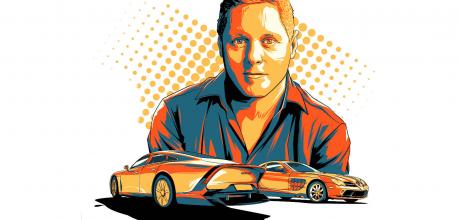Mercedes-Benz design chief Gorden Wagener tells all
Under Gorden Wagener, Mercedes has the most consistent design language of the German big three. But what's next?
‘TECH IS NOTHING WITHOUT DESIGN’
THE CAR INQUISITION – GORDEN WAGENER MERCEDES-BENZ GROUP DESIGN CHIEF
Gorden Wagener loves Mercedes. Ever since joining its design department in 1997 he’s been a one-company man, rising quickly through the ranks from sketching supercars like the SLR McLaren to leading the team behind the sales-breakthrough 2012 A-Class Mk3.
‘WE ARE IN A TECH BUSINESS, ESPECIALLY THIS DECADE. CARS ARE BECOMING ROLLING SUPERCOMPUTERS’
Since landing the top design job at 38 years old in 2008 he’s help transform the brand from slightly stuffy and conservative – and with some below-par interiors – to one of the strongest premium-luxury brands, with simple and elegant exteriors and class-leading cabins. Chief design officer since late 2016, he now oversees the aesthetics of everything Mercedes creates, from cars to showrooms, including everything digital.
CAR caught up with the 54-yearold at his Nice design studio in southern France to ask how he plans to keep up the momentum. ‘Mercedes was always a very engineering- driven company, which is not a bad thing; it made the company big,’ he says. ‘But now it’s about two things: tech and design. That’s our definition of luxury and you can’t do it without tech, because we are in a tech business, especially this decade. Cars are becoming rolling supercomputers. But tech is nothing without design. We’re moving in the right direction and keep evolving our “sensual purity” design philosophy, which makes the brand beautiful and extraordinary.’
Despite his powerful position, Wagener isn’t formally part of the executive committee. ‘I don’t want to sit in a lot of boring meetings, but I am at board level,’ he clarifies. ‘I report to the board and am grateful to have a lot of influence in the company and can make design strong’. So what kinds of cars are his team working on now? ‘The focus this decade is 60 per cent SUV, 30 per cent limousine and 10 per cent speciality vehicles, like sports cars or whatever.
Then there are crossover possibilities in between – a low limousine and a high SUV. We have done mono-volume concepts too. Back in 2015, when we showed the F 015 concept that was a totally new approach, and when I talk to people like Apple, they said, “That’s exactly what we had in mind and is so cool” – that’s a quote – but I don’t know what they will actually come up with.’
The working F 015 concept predicted an autonomous future where driving was optional and interior experience optimal, but eight years later that moment still seems far off. ‘When it comes to increasing autonomy, it’s taken longer than we thought,’ he concedes, ‘but it will get better and eventually be here and then you’ll want more space in the cabin. When you’re stuck in traffic you’ll want this “third space” [neither home nor office]. So do we want to have a more mono-volume vehicle that takes advantage of a better footprint?
Our EQS and EQE cars are already cab-forward to create more cabin space, but they’re lower as that makes them more aero-efficient which is crucial for EVs. However, maybe one day there will be a Mercedes a bit like the F 015.’ The mono-volume is certainly a logical shape for maxing-out interior space, but traditional MPVs now sell poorly in Europe. ‘It’s very important to give the vehicle a luxury positioning. In Asia the [Toyota] Alphard is a luxury, high-price car. In the US they see it as a van, and in Europe it’s a bus, but maybe autonomy could change that in 10 years.’
For high levels of autonomy the interior user experience – whether via touchscreens, head-up display or voice control – will need to be topnotch too. Mercedes is currently leading the screen-size arms race with its full-width Hyperscreen.
‘The next level we have already shown on the 2022 EQXX concept is full-width but one screen under one glass, rather than three screens like in the Hyperscreen. That opens up even more possibilities and use cases. We will use Unity gaming-engine software for our interface, which is almost like a jump from a Nokia to an Apple iPhone, from a two-dimensional digital world to a three-dimensional one. It’s a completely different way of programming which makes it easier to change too.’ There are plenty of very different design decisions to be wrestled into reality within a rapidly transforming industry, then. But while the influence of design at rivals BMW and to some extent Audi appears to be weakening, Wagener – ever-confident and ever the optimist – will look to keep his beloved brand on track.
2015’s F 015 ‘lounge on wheels’ concept


